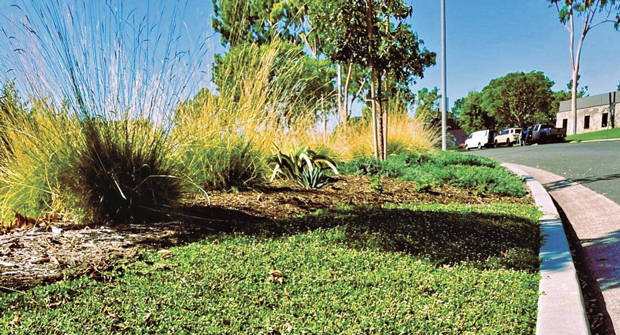Landscaping trends that can help save water
Moreno says Kurapia, a low-lying ground cover, is gaining in popularity as a turfgrass alternative in the Western US (Photo: Max Moreno)
Climate change and dwindling resources present the landscape industry with challenging obstacles and new solutions never tried before. In the Western half of the US, we face the challenge of maximizing one of our most precious resources: water.
As another year passes, state and local government agencies require that we continue to reduce our water consumption from designated watering days to specific windows of watering time for landscaping. Water conservation is another challenge we must face and overcome, alongside rising labor and inflation costs. But as always, our industry is up for the challenge of providing solutions and opportunities by setting emerging trends.
Like most people, I enjoy having lush, green open spaces, and if you travel through southern California, these spaces are changing because of water conservation. Since turfgrass is one of the most highly water-consuming plant species, professionals must consider options for reducing or eliminating turf in certain areas. This trend is making these areas more water efficient and redefining the landscape’s appearance to be more aligned with the region.
Another type of ground cover
As Vice President of Water Conservation for Harvest Landscape, people ask me about reducing turf while keeping the look and feel of turf. I refer to some of my early experiences with Kurapia, which is rapidly gaining popularity. Kurapia is a versatile low-lying ground cover with the appearance of grass from afar. It offers many benefits, the most important being drought tolerance.
By pairing Kurapia with pressure-regulating sprinklers and high-efficiency nozzles, we now have a solution many clients have been looking for. With Kurapia, you can kill two birds with one stone by reducing the labor necessary to maintain turf and still have the lush green look you desire.
Emerging education
Another emerging trend is the concept of water-efficient, sustainable landscaping through design, construction and maintenance that encompasses ecologically sound practices. This trend is gaining popularity through educational programs like the Qualified Water Efficient Landscaper (QWEL) program, a program of the Sonoma-Marin Saving Water Partnership in California. Sustainable landscaping practices pertaining to irrigation may include converting existing, outdated irrigation to a highly effective and efficient system.
Typically, contractors convert landscape areas from overhead to drip or point source irrigation. By doing so, we increase irrigation efficiency while also reducing wastewater. I highly recommend this water-conserving technique because it adds to the transformation into a water-efficient, sustainable landscape, which is ideal for long-term viability.
I regularly get called to do third-party irrigation audits for new irrigation construction. In California, all new developments must meet criteria the state sets in the Model Water Efficient Landscape Ordinance (MWELO). Many new irrigation development projects are now a two-wire irrigation system.
Traditional irrigation systems typically have wires run to each valve, whereas a two-wire irrigation system requires only two wires throughout the whole system. With the rise in the cost of materials and labor, a two-wire system reduces the amount of copper wire while consolidating irrigation controllers.
This new direction is significant for landscape maintenance contractors, as they must understand how these systems operate and how to maintain them. Two-wire education is becoming more popular because of the operation and maintenance of these systems.
Adapting to these emerging trends is both vital and beneficial to our industry. If we keep up and adapt to the trends, we will be able to provide the best service to our clients and Mother Earth.


Comments are closed.